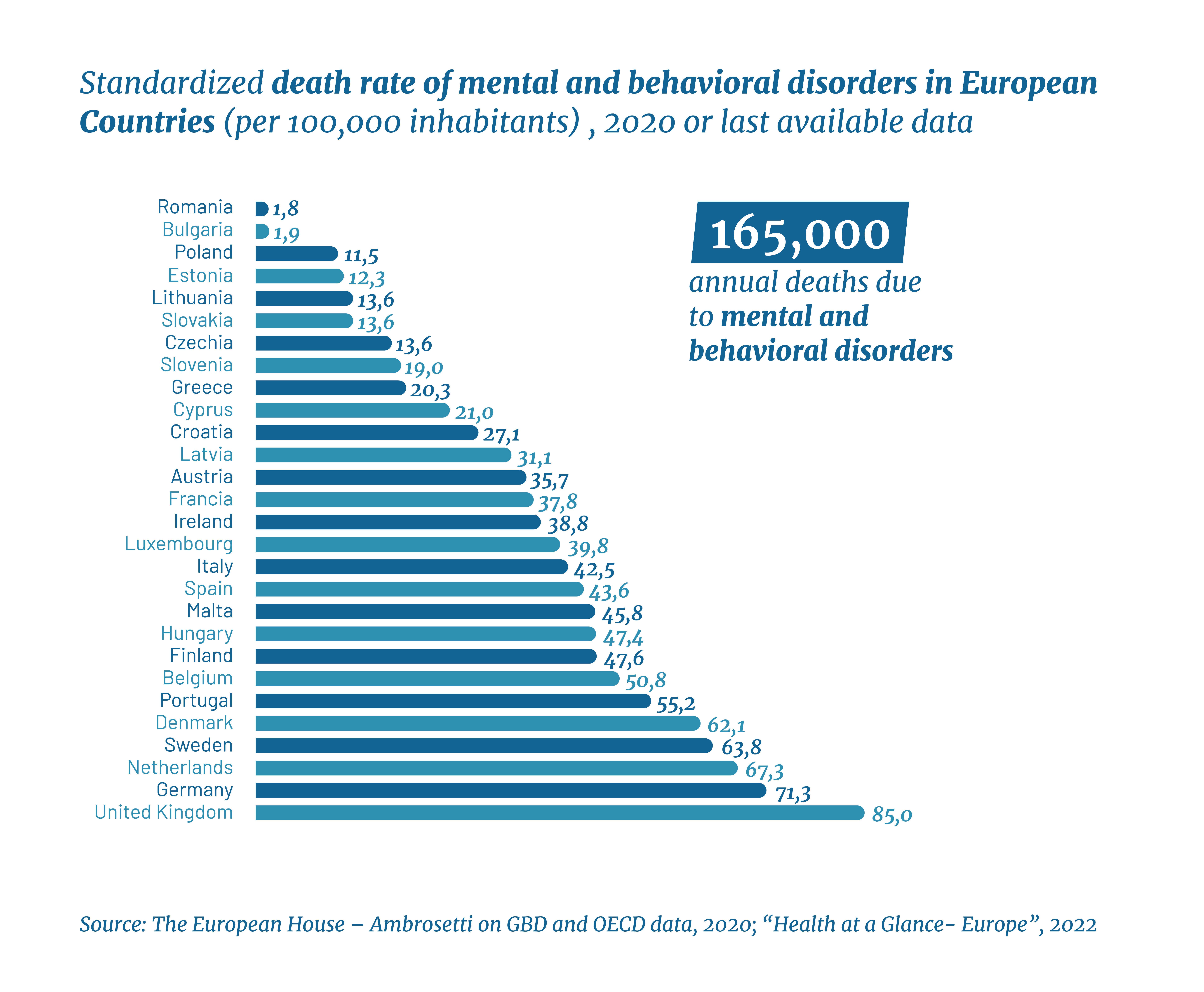The incidence of mental disorders in European countries

Analysis of the results published in the latest report Headway - A new roadmap in Mental Health (2022), an initiative created by Think Tank The European House – Ambrosetti in partnership with Angelini Pharma.
One in six people in Europe lives with a mental disorder such as anxiety, depression and bipolar disorders every day. A silent army of more than 110 million people.
The estimates come from the World Health Organization which is analysing the tangible effects that COVID-19 left amongst European citizens, as well as elsewhere. According to the first estimates, in Europe the pandemic led to a 25% increase in mental disorders, especially anxiety and depression. The fear is that, if action is not taken immediately, the long-term effects could be far more severe in percentage terms.
The latest report Headway - A new roadmap in Mental Health (2022), an initiative conceived and launched by Think Tank The European House – Ambrosetti in partnership with Angelini Pharma, attempted to draw up a map of mental health in Europe, a challenging task, given the great differences from one country to the next. In Finland and Ireland, for example, it is estimated that the mental disorders that came to light post-pandemic are around 5%, whereas in countries like Croatia and Portugal the percentage rises to 20%.
The increase in mental disorders had attracted the attention of the institutions well before the COVID-19 pandemic. It is estimated that in 2019 mental disorders in Europe were responsible for 16.9 million YLD (Years lived with disability of Mental Health disorders). According to these data, depressive disorders represent 5.4% of all years lived with disability (YLD), making it the fourth major cause of YLD in the EU area. They are followed by anxiety and schizophrenia, which occupy 6th and 19th place respectively.
In Europe, approximately 4% of all deaths is caused by mental and behavioural disorders. According to some studies, individuals with severe mental disease have a higher premature mortality rate than the general population.
An in-depth analysis of the phenomenon in the 27 countries of the EU plus the UK shows that the countries with the highest mental disorder mortality rates are the UK, Germany, Holland, Sweden, Denmark and Portugal, Belgium, Finland, Hungary, Malta and Spain. The categories most affected by the phenomenon are women and people over 65.

The WHO estimates that in Europe mental disorders are responsible for 140 thousand deaths a year from suicide, making it the 6th cause of death in the population under 70 years of age and the 4th in that under 20 years of age. Once again in this case the situation varies greatly from one country to another. The highest percentages are found in the areas of Lithuania and Latvia, and are 20.2% and 16.1%, respectively, per 100 thousand inhabitants. In Greece (3.6) and Cyprus (4.1) the phenomenon is less common.
Unfortunately, mental disorders are amongst the major causes of suicide in juveniles, particularly in the 15 - 19 years age range. According to the latest data collected, in 2017 more than one thousand adolescents, particularly boys, took their own life due to mental problems.
The main risk factors for mental health undoubtedly include alcohol and drug addiction. In 2020, more than 140 million people in Europe (32.9% of the total population) stated that they had had problems with alcohol in the previous 30 days. It is estimated that 83.4 million people aged between 15 and 64 years, i.e. 29% of the European population, have used drugs at least once in their life. The drug addiction phenomenon above all regards young people between 15 and 34 years of age. According to the most recent data, in 2021 some 17.4 million youngsters, i.e. 16.9%, were drug users. The highest consumption of drugs is in countries such as France, Spain and Denmark (between 45% and 38.9%). The lowest are in Hungary and Malta (7.9% and 1.4%, respectively).
There are also increasingly emerging phenomena, such as bullying and sexual abuse, which represent a significant risk factor for the development of mental disorders. In 2020, 28.2% of the juvenile population in Europe declared to have had at least one experience of bullying in the previous month. There has also been an increase in cyberbullying, which predominantly affects very young individuals of between 9 and 16 years of age. More than 80% of European youngsters in this age range declared that they had been a victim of this phenomenon. As far as sexual abuse of minors is concerned, the number of victims in Europe, again in 2020, was 22 million. The countries with the highest incidences were France, Latvia, Luxembourg and Holland. A huge number of people that, in addition to having experienced this abuse, will be more likely to develop mental disorders during the course of their life.
